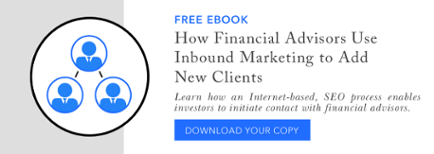What Does That Mean? Financial Advisor Marketing Terminology Explained
Here’s how it usually goes: You’ve decided you need a Digital Marketing plan to further your financial advisor prospecting strategy, and that means you can do it yourself or you can hire a marketing firm to do it for you. So, you start to do some initial research, but the jargon is really confusing! What does that even mean? You figure you should hire a marketing firm and rely on the experts, but you still don’t understand the terminology or what the firm is doing for you.
So, this is how we want to help: Whether you’re putting together a plan yourself or hiring a firm to do it for you, we’ve created this short guide to help you understand what’s what.
Once you understand what we’re saying, it all makes sense!
Inbound Marketing
Inbound Marketing is the future, especially for financial advisors. It’s an investor-focused strategy that uses the Internet to produce leads and convert them into clients. At its core, Inbound Marketing is based on letting investors find and contact advisors, and not the other way around.
Outbound Marketing
Bottom line, Outbound Marketing is the past! Financial advisors have used Outbound Marketing for decades to initiate contact with investors. This includes strategies like hundreds of cold calls per day, mass emails and thousands of pieces of direct mail. Outbound Marketing also typically means rejection rates approaching 100 percent and lots of wasted time and expense for little or no return on investment. Today, Outbound Marketing is even tougher when investors use caller ID and spam filters to avoid advisors.
Blog
A blog is one of the core foundations to an effective Inbound Marketing strategy. A business (or individual) writes articles about topics that are specific to the type of client they are targeting. These articles (also called “posts”) help drive targeted visitors to a financial advisor website. The posts establish you as a subject matter expert on a topic and enhance your visibility on the Internet, which ultimately helps turn website visitors into actual revenue-producing clients.
Call-To-Action (CTA)
As mentioned above, a CTA is merely a free offer. It can be a link, button or image that encourages a website visitor to take some sort of action on an advisor’s website or blog. Examples of CTAs include: “Get Our Free eBook,” “Subscribe” or “Click Here to Contact Us.” Convincing and relevant CTAs on a website or blog can drive visitors to take some form of action so they turn into a lead.
Persona
A persona is a representation of your ideal client. Many firms have more than one. Ideally, your entire marketing strategy will be based around your personas so your website, blog and free offers all focus on the target clients you wish to work with.
Landing Page
A landing page is a website page that contains a lead-generation form, along with an explanation of a free offer. When a lead clicks on a CTA, a landing page is where they’re taken. Good financial advisor websites have landing pages for various stages of the persona’s buying journey, such as:
- Awareness phase (eBooks, research reports, whitepapers)
- Consideration phase (expert guides, videos, comparison papers)
- Decision phase (product/vendor comparisons, case studies, demos)
Keywords
Keywords are the terms and phrases that a potential client will type into a Google search to find your site. You must include popular and specific terminology in your blogs and landing pages so Google can find it and rank you higher in a lead’s search results.
Backlink
A backlink is an internal or external link usually in your blog posts. When you write an article, you want to make sure that there are links to other pages on your website as well as to websites of leading industry experts. Not only does this give you better ranking status with Google, but it also gives your potential client a better experience and therefore, a better chance of earning their trust as they become a client.
Search Engine Optimization (SEO)
SEO is about making sure that Google (and other search engines like Bing and Yahoo) can easily find your webpages. By enhancing a webpage’s title, description, image tags and inbound links, you can improve where a webpage appears in search engine results.
Drip Campaigns
Drip campaigns are a series of emails that help move a lead through the nurturing process and the buyer’s journey in an automated fashion. For example, if someone downloads a free eBook, an automated email can be set up to respond to that client and provide them with more information as they go through the informational stage. If a financial advisor provides the right advice at the right time, chances are that lead will come to you with their financial needs. And the best part: Once it’s set up, a drip campaign is completely automated, which means there is no extra time required to manually send out emails to prospects. Drip campaigns can be very powerful automation tools to help manage your marketing campaigns.
Analytics
Analytics are a reporting system for your website. These tools let you know what is and isn’t working on your website. Detailed reports can even show you how many times someone did (or did not) click on a free offer, read a blog post or even go to a secondary page on your website before leaving. This information allows you to change what’s wrong on your site and improve the client experience overall. If you’re looking to work with a Digital Marketing firm, make sure they offer some sort of analytics.
Organic Traffic
Organic traffic refers to the website visits you receive organically – not by directly typing in your website or following a link in an email, but by searching basic terms and coming across your site in search results. This type of website traffic is invaluable.
Citations
A citation is another word for an online listing, like those on Yelp. Adding your information to appear in these lists is often free and can direct a possible lead to your website. For example, when you type in “financial advisor near me,” and a list of local firms appear in the results, you want to make sure that you not only appear on these lists but that you appear with current and correct information.


